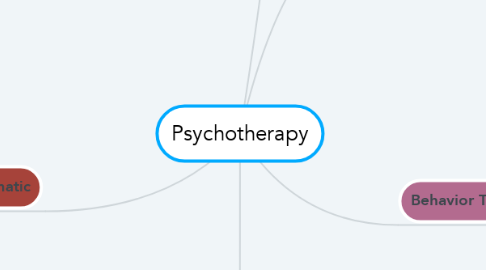Psychotherapy
by Laura Grujic Stephan

1. Group Therapy
1.1. Meeting with the whole family is helpful because of patterns in the group as a whole and when evaluating the interaction between members
1.2. Focuses on altering the behaviour of the whole family rather than one member
1.3. Self- help groups, family therapy and couples therapy
2. Somatic
2.1. Focuses on imbalances in neurotransmitters, abnormalities in the brain or genetic predisposition
2.2. Treatment of disorders varying from anxiety disorders (barbiturates) to mood disorders (chemotherapy) to schizophrenia (antipsychotics)
2.3. Treatments include ECT (electro compulsive therapy), drugs and psychosurgery.
3. Humanistic
3.1. Helps people to understand and accept themselves and reach one's highest potential
3.2. People are good and control their own destinies
3.3. Created by Carl Rogers; unconditional positive regard is the acceptance and support of a person regardless of what they say or do
3.4. Client-centered therapy
3.5. Used for substance abuse and eating disorders
4. Psychoanalysis
4.1. Technique developed by Sigmund Freud
4.2. View the cause of disorders as unconscious conflicts, therefore, focusing on the underlying cause of the problem
4.3. Patients usually suffer from symptom substitution, which happens when one disorder is successfully treated and a new one appears
4.4. Hypnosis, free association and dream analysis were techniques used by Freud for interpretation
4.5. Used for depression, GAD and sexual harassments
5. Behavior Therapy
5.1. Believes that all behaviour is learned through classical conditioning, operant conditioning and modelling
5.2. Contercounditioning developed by Mary Jones is when an unpleasant conditioned response is replaced with a pleasant one
5.3. Systematic Desensitization developed by Joseph Wolpe replaces one's feelings of anxiety with relaxation through various techniques


